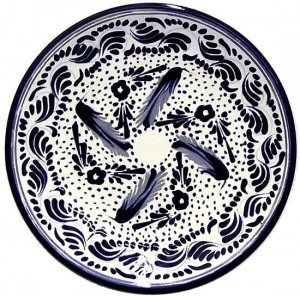 Talavera is a type of maiolica earthenware, distinguished by its white base glaze. Authentic Talavera pottery only comes from the city of Puebla and the communities of Atlixco, Cholula and Tecali, as the clays needed and the history of this craft are both centered there. All pieces are hand-thrown on a potter’s wheel and the glazes contain tin and lead, as they have since colonial times. This glaze must craze, be slightly porous and milky-white, but not pure white. There are only six permitted colors: blue, yellow, black, green, orange and mauve, and these colors must be made from natural pigments. The painted designs have a blurred appearance as they fuse slightly into the glaze. The base, the part that touches the table, is not glazed but exposes the terra cotta underneath. An inscription is required on the bottom that contains the following information: the logo of the manufacturer, the initials of the artist and the location of the manufacturer in Puebla.
Talavera is a type of maiolica earthenware, distinguished by its white base glaze. Authentic Talavera pottery only comes from the city of Puebla and the communities of Atlixco, Cholula and Tecali, as the clays needed and the history of this craft are both centered there. All pieces are hand-thrown on a potter’s wheel and the glazes contain tin and lead, as they have since colonial times. This glaze must craze, be slightly porous and milky-white, but not pure white. There are only six permitted colors: blue, yellow, black, green, orange and mauve, and these colors must be made from natural pigments. The painted designs have a blurred appearance as they fuse slightly into the glaze. The base, the part that touches the table, is not glazed but exposes the terra cotta underneath. An inscription is required on the bottom that contains the following information: the logo of the manufacturer, the initials of the artist and the location of the manufacturer in Puebla.
Today, only pieces made by designated areas and from workshops that have been certified are permitted to call their work “Talavera.”
